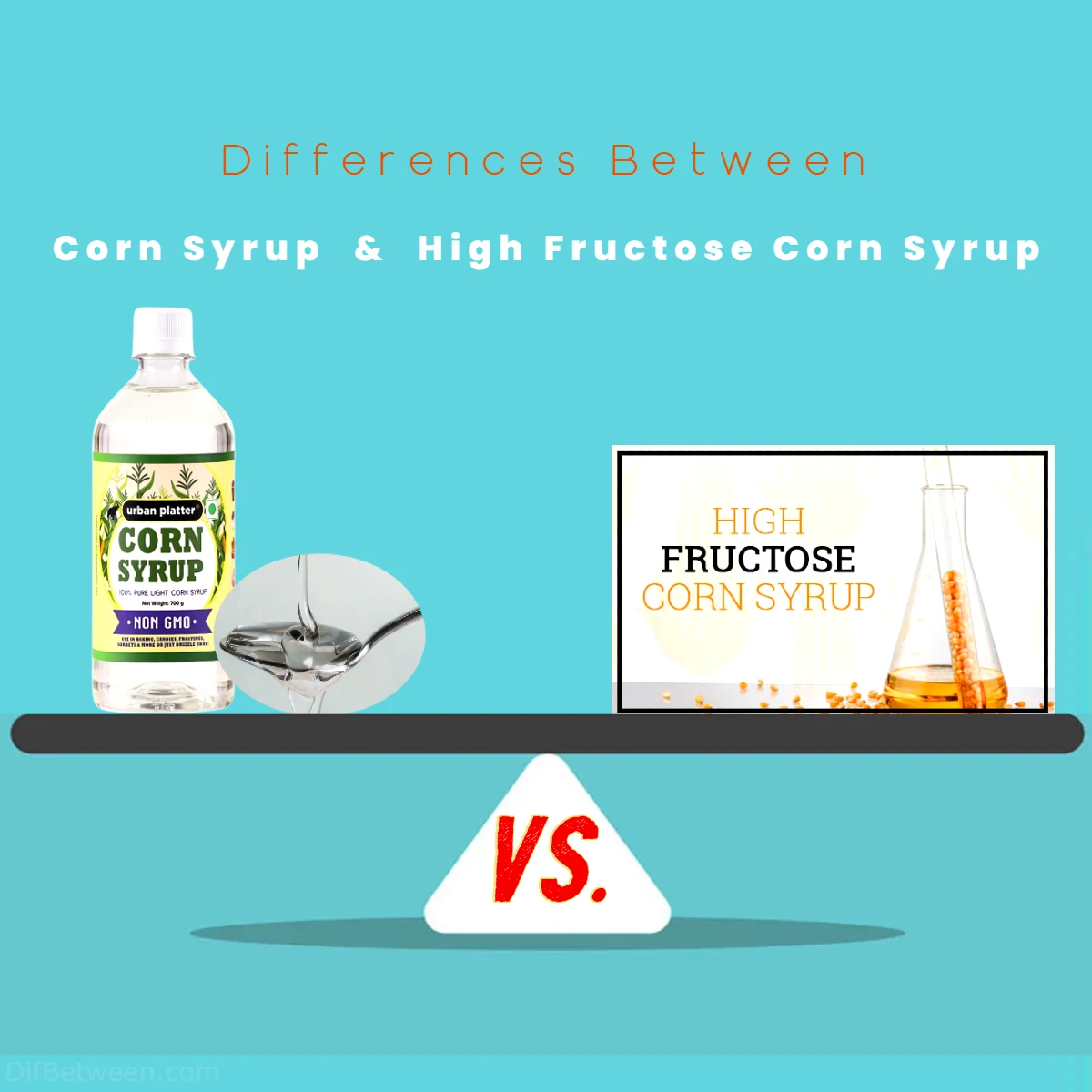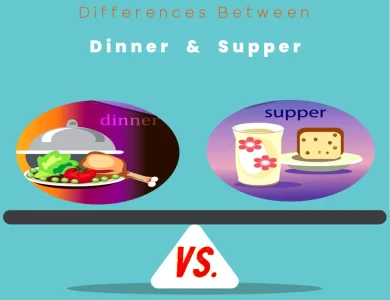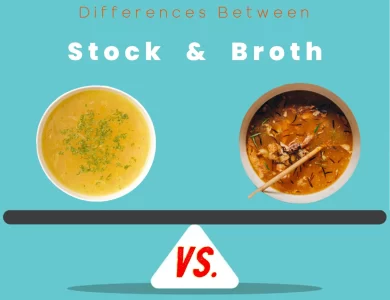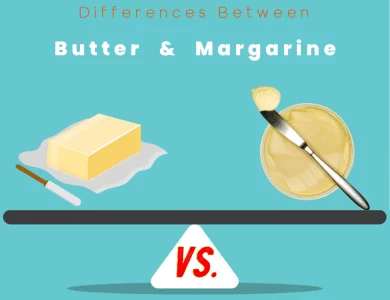
| Characteristic | Corn Syrup | High Fructose Corn Syrup (HFCS) |
|---|---|---|
| Composition | Primarily glucose, minimal fructose | Mix of glucose and higher fructose |
| Fructose Content | Less than 1% | HFCS-42 (42% fructose) or HFCS-55 (55% fructose) |
| Sweetness | Less sweet compared to sucrose | Sweeter due to higher fructose content |
| Common Uses | Baking, confectionery, homemade syrups, sauces, marinades, ice cream | Soft drinks, processed foods, convenience foods, snack foods |
| Health Implications | Fewer concerns due to low fructose content | Concerns about obesity, type 2 diabetes, liver health, and heart health with excessive consumption |
| Availability | Widely available in grocery stores | Found in processed foods and rarely sold directly to consumers |
| Cost | Generally more affordable | Often more expensive due to additional processing |
| Substitution Options | Honey, maple syrup, agave nectar, brown rice syrup | Table sugar (sucrose), invert sugar, fruit purees |
| Moderation | Should still be consumed in moderation | Should be consumed sparingly due to health concerns |
In the realm of sweeteners, two often-discussed options are corn syrup and high fructose corn syrup (HFCS). If you’ve ever found yourself pondering which syrup to reach for while baking or when scrutinizing food labels, you’re not alone. These syrupy siblings might look similar, but they have distinct characteristics that can significantly impact your recipes and your health.
Differences Between Corn Syrup and High Fructose Corn Syrup
The main differences between Corn Syrup and High Fructose Corn Syrup (HFCS) lie in their composition and sweetness. Corn syrup is primarily composed of glucose with minimal fructose content, usually less than 1%, making it less sweet compared to HFCS. In contrast, HFCS contains a significant amount of fructose, with variants like HFCS-42 (42% fructose) and HFCS-55 (55% fructose), giving it a sweeter taste. These distinctions have a substantial impact on their respective uses in cooking, baking, and the food industry, as well as potential health considerations, making it important to choose the right syrup for your specific needs and dietary preferences.
The Basics
Corn Syrup: Corn syrup is a sweet syrup made from the starch of maize (corn). It’s a glucose syrup, which means it primarily consists of glucose molecules. This syrup is widely used in the food industry for various purposes, including sweetening products, preventing sugar crystallization in candies and desserts, and enhancing texture in baked goods.
High Fructose Corn Syrup (HFCS): High fructose corn syrup, on the other hand, is a more processed sweetener derived from corn syrup. It undergoes enzymatic processing to convert some of its glucose into fructose. HFCS is available in different forms, with varying fructose content. The most common types are HFCS-42 (which contains 42% fructose) and HFCS-55 (which contains 55% fructose). This fructose-glucose blend is often used as a sweetener in soft drinks, processed foods, and candies.
Sweetening the Deal: Key Differences
Now that we know the basics, let’s dive into the key differences between corn syrup and high fructose corn syrup.
1. Composition
Corn Syrup: Corn syrup is primarily composed of glucose molecules, which are simple sugars. It contains little to no fructose, typically less than 1%.
High Fructose Corn Syrup (HFCS): As the name suggests, high fructose corn syrup contains a significant amount of fructose in addition to glucose. HFCS-42 has 42% fructose, while HFCS-55 has 55% fructose. This higher fructose content sets HFCS apart from regular corn syrup.
2. Sweetness
Corn Syrup: Corn syrup is not as sweet as table sugar (sucrose). Glucose, its main component, is less sweet than both glucose and fructose when compared on a per-gram basis. This makes corn syrup a less intense sweetener.
High Fructose Corn Syrup (HFCS): High fructose corn syrup is sweeter than corn syrup due to its fructose content. Fructose is naturally sweeter than glucose, so products sweetened with HFCS can taste sweeter than those made with corn syrup.
3. Usage in Food Industry
Corn Syrup: Corn syrup is commonly used in baking and confectionery for its ability to prevent sugar crystallization and improve texture in products like candies, syrups, and frostings. It’s also a common ingredient in some savory dishes to add a touch of sweetness.
High Fructose Corn Syrup (HFCS): HFCS is prevalent in the soft drink industry, where it is used to sweeten carbonated beverages. It’s also found in many processed foods and snacks, including ketchup, salad dressings, and canned fruits, where its sweetness is utilized to enhance the flavor profile.
4. Health Implications
Corn Syrup: Corn syrup, being primarily glucose, is not high in fructose. It is metabolized by the body differently than fructose, which means it doesn’t have the same potential negative health effects often associated with excessive fructose consumption.
High Fructose Corn Syrup (HFCS): The higher fructose content in HFCS has been a subject of concern in recent years. Excessive consumption of fructose, particularly in the form of HFCS, has been linked to obesity, type 2 diabetes, and other health issues. It’s important to note that moderation is key when it comes to HFCS consumption.
5. Availability
Corn Syrup: Corn syrup is widely available and can be found in most grocery stores. It is typically sold in liquid form, and some common brands include Karo and Crown.
High Fructose Corn Syrup (HFCS): HFCS is also readily available, especially in processed foods and soft drinks. It is rarely sold directly to consumers in its syrup form for home use.
6. Cost
Corn Syrup: Corn syrup is generally more affordable than high fructose corn syrup, which makes it an attractive option for manufacturers and home bakers.
High Fructose Corn Syrup (HFCS): Due to the additional processing required to convert corn syrup into HFCS, it is often more expensive than regular corn syrup. This cost difference can influence its use in various products.
Sweetening the Pot: Common Uses
Let’s take a closer look at how these two sweeteners are commonly used in the food industry and everyday cooking.
Uses of Corn Syrup
1. Baking and Confectionery: Corn syrup is a staple in baking and candy making. Its ability to prevent sugar crystallization and improve the texture of products like fudge, caramel, and nougat is highly valued by bakers and confectioners.
2. Homemade Syrups: Many homemade syrups, like pancake syrup and fruit-flavored syrups, are made with corn syrup as a base. It provides a smooth, pourable consistency and adds sweetness without crystallizing.
3. Sauces and Marinades: Corn syrup is sometimes used in barbecue sauces, glazes, and marinades to balance flavors and add a touch of sweetness.
4. Ice Cream and Frozen Desserts: It helps in creating a smoother texture in ice creams and frozen desserts by reducing the formation of ice crystals.
Uses of High Fructose Corn Syrup (HFCS)
1. Soft Drinks: One of the most well-known uses of HFCS is in carbonated soft drinks. It’s the primary sweetener in many popular sodas and fruit-flavored beverages.
2. Processed Foods: HFCS can be found in a wide range of processed foods, including canned fruits, baked goods, breakfast cereals, and salad dressings. Its sweetness enhances the flavor of these products.
3. Convenience Foods: Fast food items like burgers, chicken nuggets, and condiments often contain HFCS in various forms.
4. Snack Foods: Chips, crackers, and other snack foods may include HFCS to enhance their taste and shelf life.
Sweetening the Deal: Health Considerations
While both corn syrup and high fructose corn syrup have their uses in the food industry, there are important health considerations to keep in mind.
Health Considerations for Corn Syrup
Corn syrup, being primarily composed of glucose, has a different metabolic pathway in the body compared to fructose. Glucose is readily absorbed by cells and used for energy. It does not significantly impact liver function or cause the same metabolic issues associated with excessive fructose consumption.
That said, it’s important to remember that corn syrup is still a source of empty calories and should be consumed in moderation. Excessive sugar intake, regardless of the source, can contribute to weight gain and other health problems.
Health Considerations for High Fructose Corn Syrup (HFCS)
High fructose corn syrup, particularly HFCS-55, has raised concerns due to its high fructose content. Unlike glucose, fructose is primarily metabolized by the liver. Excessive fructose consumption can lead to several health issues, including:
1. Obesity: High fructose intake has been associated with increased body fat accumulation, especially around the abdomen.
2. Insulin Resistance: It can lead to insulin resistance, a condition where the body’s cells don’t respond effectively to insulin, potentially leading to type 2 diabetes.
3. Fatty Liver Disease: Excess fructose can contribute to the development of non-alcoholic fatty liver disease (NAFLD), a condition that affects liver function.
4. Increased Risk of Heart Disease: Some studies suggest that high fructose consumption may contribute to heart disease risk factors, such as elevated triglyceride levels and high blood pressure.
It’s essential to be mindful of your overall sugar intake and pay attention to food labels to identify products containing HFCS. Reducing the consumption of foods and beverages high in HFCS can contribute to better overall health.
Sweetening the Pot: Substituting Corn Syrup and HFCS
If you’re looking to reduce your consumption of corn syrup or HFCS for health reasons or dietary preferences, there are alternative sweeteners and substitution options available.
Substituting Corn Syrup
1. Honey: Honey is a natural sweetener that can be used in place of corn syrup in many recipes. It has a similar consistency and sweetness.
2. Maple Syrup: Maple syrup is another natural option that can replace corn syrup in recipes, especially in desserts and breakfast dishes.
3. Agave Nectar: Agave nectar is a liquid sweetener derived from the agave plant. It can be used as a one-to-one substitute for corn syrup.
4. Brown Rice Syrup: Brown rice syrup is less sweet than corn syrup but works well in recipes where a milder sweetness is desired.
Substituting HFCS
Substituting high fructose corn syrup can be a bit more challenging due to its unique properties. However, you can try the following options:
1. Table Sugar (Sucrose): In recipes that call for HFCS, you can often use table sugar (sucrose) as a substitute. Keep in mind that you may need to adjust the proportions slightly, as HFCS is sweeter than sucrose.
2. Invert Sugar: Invert sugar is a mixture of glucose and fructose created by breaking down sucrose. It can be used as a substitute for HFCS in some recipes.
3. Fruit Purees: In recipes where HFCS provides sweetness and moisture, you can use fruit purees like applesauce or mashed bananas as a healthier alternative.
The Genesis of Corn Syrup and HFCS
Corn Syrup: Corn syrup is a straightforward creation. It starts with cornstarch, which is rich in starch (a long chain of glucose molecules). Through enzymatic hydrolysis, this starch is broken down into simpler sugars, primarily glucose. Corn syrup typically contains less than 1% fructose, making it primarily a glucose syrup.
High Fructose Corn Syrup (HFCS): The story of HFCS is a bit more complex. It begins with corn syrup, similar to its cousin. However, HFCS undergoes further processing, including enzymatic conversion, to increase its fructose content. There are different variants of HFCS available, such as HFCS-42 (containing 42% fructose) and HFCS-55 (containing 55% fructose), each tailor-made for specific purposes in the food industry.
Sweetness Unveiled: The Taste Test
One of the most noticeable differences between corn syrup and HFCS is their sweetness.
Corn Syrup: Corn syrup is not as sweet as table sugar (sucrose) on a per-gram basis. This is because glucose, the primary component of corn syrup, is less sweet than both glucose and fructose.
High Fructose Corn Syrup (HFCS): HFCS, with its elevated fructose content, is notably sweeter than corn syrup. Fructose, in its pure form, is sweeter than both glucose and sucrose, which is why products sweetened with HFCS often taste sweeter.
A Sweet Symphony: Applications in the Food Industry
Understanding how these syrups are employed in the food industry can shed light on their unique roles.
Corn Syrup in Action
1. Baking and Confectionery: Corn syrup is a stalwart in the world of baking and confectionery. It serves a dual purpose – preventing sugar crystallization and enhancing texture. You’ll find it in treats like fudge, caramels, and nougat.
2. Homemade Syrups: Many homemade syrups, from pancake syrup to fruit-flavored drizzles, rely on corn syrup for its smooth consistency and sweetening power.
3. Sauces and Marinades: Corn syrup often stars in barbecue sauces and marinades, balancing flavors and lending a hint of sweetness.
4. Ice Cream and Frozen Desserts: By reducing ice crystal formation, corn syrup helps achieve a smoother texture in ice creams and frozen desserts.
HFCS Takes the Stage
1. Soft Drinks: If you’re sipping on a carbonated beverage, there’s a good chance it’s sweetened with HFCS. It’s a mainstay in the soft drink industry, contributing to the characteristic sweetness of sodas.
2. Processed Foods: HFCS plays a role in preserving, flavoring, and sweetening many processed foods, including canned fruits, baked goods, breakfast cereals, and salad dressings.
3. Convenience Foods: Fast food items like burgers, chicken nuggets, and condiments often contain HFCS, adding a touch of sweetness to savory fare.
4. Snack Foods: Chips, crackers, and other snack foods owe some of their taste and shelf life to HFCS.
When it comes to health, it’s crucial to differentiate between these two syrups.
Health Considerations for Corn Syrup
1. Glucose Metabolism: Corn syrup, primarily composed of glucose, follows a different metabolic pathway in the body compared to fructose. It is readily absorbed by cells and used for energy.
2. Lower Fructose Content: With little to no fructose, corn syrup doesn’t carry the same health concerns associated with excessive fructose consumption.
3. Moderation Matters: While corn syrup is a valid ingredient in many recipes, it still contributes empty calories and should be consumed in moderation. Excess sugar intake can lead to weight gain and other health issues.
Corn Syrup or High Fructose Corn Syrup: Which One is Right Choose for You?
When it comes to sweeteners, corn syrup and high fructose corn syrup (HFCS) are two common choices. But which one should you reach for when sweetening your recipes or making dietary decisions? Let’s explore the characteristics of each to help you make an informed choice.
Corn Syrup: The Simple Sweetener
Composition: Corn syrup is primarily composed of glucose molecules. It contains little to no fructose, typically less than 1%.
Sweetness: Corn syrup is less sweet than table sugar (sucrose) on a per-gram basis. Glucose, its main component, is not as sweet as glucose and fructose.
Common Uses:
- Baking and Confectionery: Corn syrup is a go-to sweetener in the world of baking and candy making. It prevents sugar crystallization and enhances texture in products like fudge and caramel.
- Homemade Syrups: It’s used in homemade syrups like pancake syrup and fruit-flavored drizzles.
- Sauces and Marinades: Corn syrup often balances flavors and adds a touch of sweetness to barbecue sauces and marinades.
- Ice Cream and Frozen Desserts: It helps create a smoother texture in ice creams by reducing ice crystal formation.
Health Considerations: Corn syrup primarily consists of glucose, which is metabolized differently than fructose. It doesn’t raise the same health concerns associated with excessive fructose consumption. However, like all sugars, moderation is key.
High Fructose Corn Syrup (HFCS): The Sweet and Controversial
Composition: HFCS contains a significant amount of fructose in addition to glucose. HFCS-42 has 42% fructose, while HFCS-55 has 55% fructose.
Sweetness: HFCS is sweeter than corn syrup due to its fructose content. Fructose is naturally sweeter than glucose.
Common Uses:
- Soft Drinks: HFCS is a primary sweetener in carbonated beverages, contributing to their characteristic sweetness.
- Processed Foods: It’s found in a wide range of processed foods, including canned fruits, baked goods, breakfast cereals, and salad dressings.
- Convenience Foods: Fast food items often contain HFCS for flavor enhancement.
- Snack Foods: Chips, crackers, and other snacks use HFCS to improve taste and shelf life.
Health Considerations: The higher fructose content in HFCS has raised concerns about its impact on health. Excessive fructose intake, especially in the form of HFCS, has been linked to obesity, type 2 diabetes, and liver issues. Moderation is essential when consuming HFCS-containing products.
Making Your Choice
The choice between corn syrup and HFCS depends on your specific needs and preferences:
Choose Corn Syrup If:
- You’re looking for a versatile sweetener for baking and confectionery.
- You prefer a milder sweetness in your recipes.
- You want a sweetener with little to no fructose.
- You’re mindful of potential health concerns associated with high fructose intake.
Choose HFCS If:
- You’re sweetening beverages or processed foods where a sweeter taste is desired.
- You’re following a specific recipe that calls for HFCS.
- You’re aware of the potential health implications but are using HFCS in moderation.
Consider Alternatives: If you’re looking to reduce or avoid corn syrup and HFCS, there are natural sweeteners like honey, maple syrup, agave nectar, and fruit purees that can often be used as substitutes in recipes.
FAQs
The primary difference lies in their composition. Corn syrup is predominantly glucose, with minimal fructose (less than 1%). In contrast, HFCS contains a notable amount of fructose, with common variants like HFCS-42 (42% fructose) and HFCS-55 (55% fructose). This disparity in fructose content impacts sweetness and applications.
HFCS is sweeter than corn syrup. Fructose, found in HFCS, is naturally sweeter than glucose, which is the primary component of corn syrup. The higher fructose content in HFCS contributes to its sweeter taste.
Yes, in some cases. Corn syrup can often be used as a substitute for HFCS in recipes, but you may need to adjust the proportions as HFCS is sweeter. Consider the sweetness level and texture requirements of your recipe when making substitutions.
Yes, there are concerns linked to excessive HFCS consumption. Its high fructose content has been associated with obesity, type 2 diabetes, liver health issues, and potential heart disease risk factors. It’s important to consume HFCS-containing products in moderation.
Corn syrup is readily available in most grocery stores, typically sold in liquid form. HFCS, on the other hand, is more commonly found in processed foods and beverages rather than being sold directly to consumers.
Yes, there are natural sweeteners like honey, maple syrup, agave nectar, and fruit purees that can often be used as substitutes for corn syrup and HFCS in recipes. These alternatives offer different flavors and sweetness levels.
Read More:
Contents






